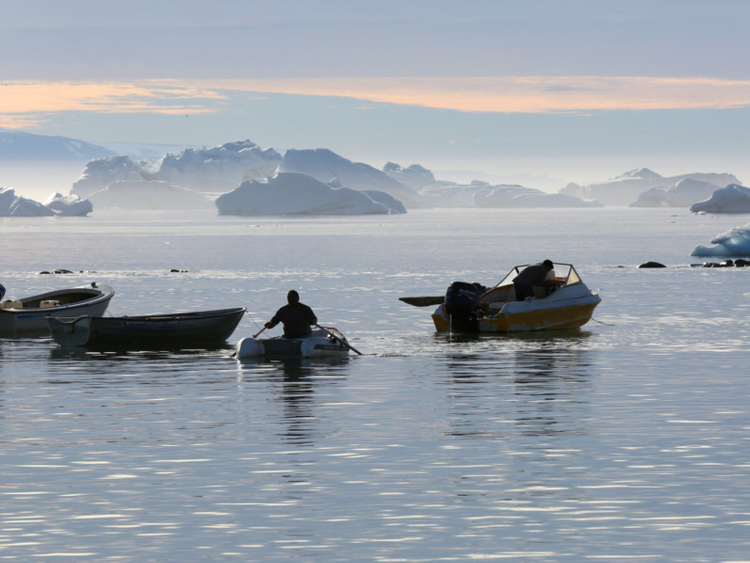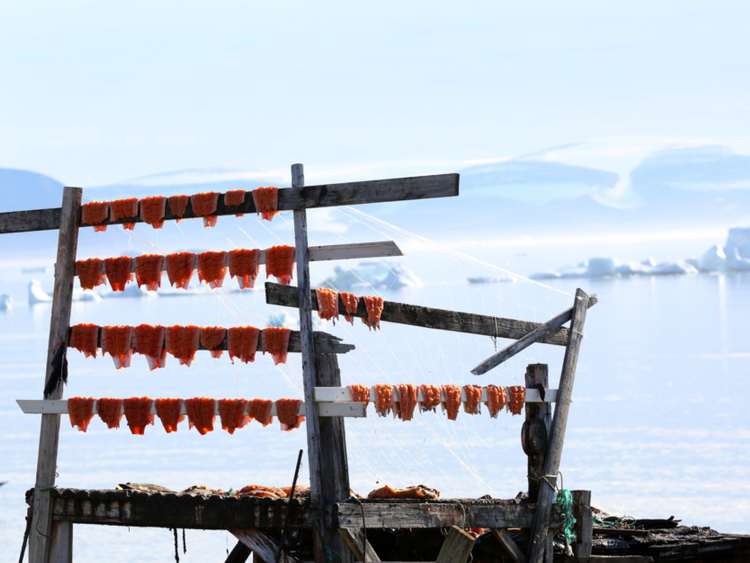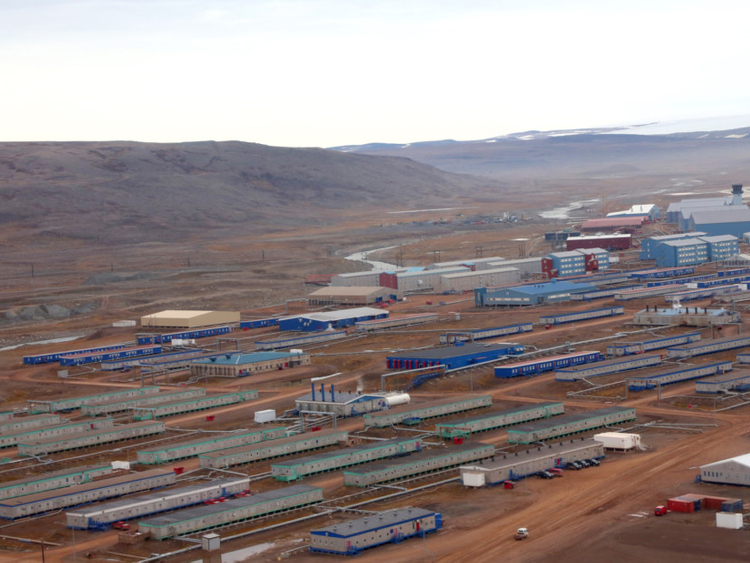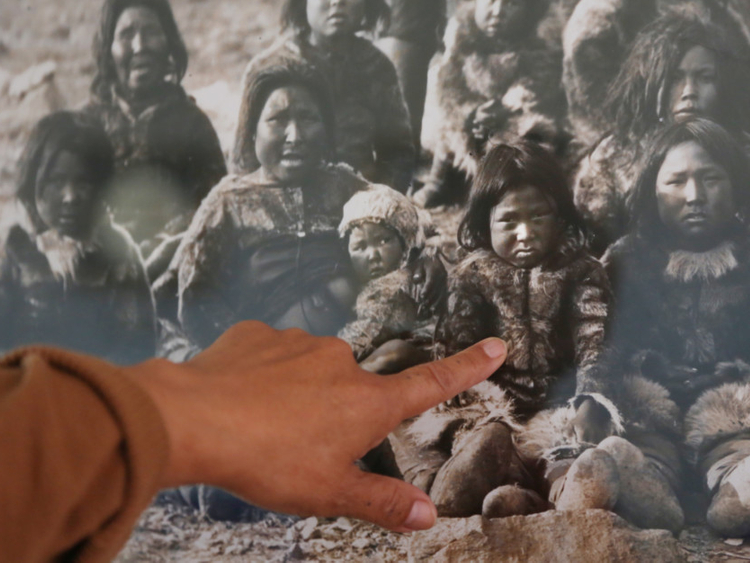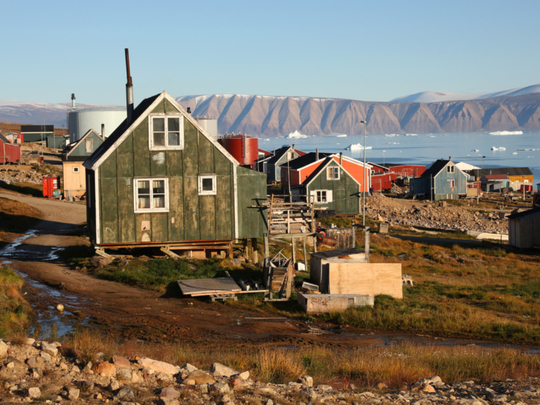
Qaanaaq, the northernmost village in Greenland sits just shy of 78 degrees north latitude — deep in the Arctic — yet during the summer, meltwater is everywhere. It flows in small rivulets and larger streams, past multicoloured houses built against a sloping hill and down to the Inglefield Bredning, as it is called in Danish — a broad body of water at the confluence of several fjords.
Since the Inugguit people arrived in this village in 1953, life has been focused on hunting in and around this gulf, a summer habitat for narwhals, the rare whales with long, spearlike tusks that give them a mythic quality. In winter, the six-mile-wide body of water freezes solid enough to drive a car on; in summer, it is choked with enormous icebergs from nearby glaciers. Fragments of ice wash ashore along the beach here or loudly tumble in the shallows with the tides.
Traditionally, the inhabitants of this town of 630 would harpoon narwhals from kayaks in the summer and then in the winter use dog sleds to travel across the ice to hunt seals, walruses, polar bears and other marine mammals. They voyaged many miles, up and down the coast. Even today, Qaanaaq’s residents collectively own hundreds of dogs, chained to nearly every home, it seems, and constantly howling.
But the age-old Inugguit lifestyle is changing fast as the climate warms, disrupting long-held patterns and possibilities and forcing economic challenges as a traditional hunting culture weighs new industries such as fishing and even tourism.
Qaanaaq has the trappings of modernity — a hotel, retirement home, diesel power plant, museum, church, school — but it is extremely remote. In general, Greenland is heavily subsidised by Denmark under a self-government arrangement, receiving nearly $540 million in 2015 from the European nation.
“Today, you don’t raise boys to be a hunter from when they were small,” said Jens Danielsen, the village’s municipal leader, who spoke in Inuktun — a Greenlandic dialect spoken by only 700 people worldwide. (Navarana Sorensen, a villager who picked up English in Denmark and Canada, partly translated and partly paraphrased his words.)
“Now you tell them, you have to get a better education by going to school,” he told two journalists who visited the village late last summer. “That’s how the lifestyle has changed a lot.”
Danielsen said hunting patterns have been strongly altered by environmental changes. In the 1980s and 1990s, he said, the ice in the fjord would be safe to travel upon by mid-October every year. Today, he said, sometimes that deep freeze doesn’t come until mid-December. It’s no longer safe, he added, to take sleds out to the islands at the mouth of the fjord to hunt for walruses.
“Earlier, the hunters, they can just look at the weather and see how it is going to be the next few days, so I can go out,” he said. “But today, you can’t do that anymore, because the change of the weather happens from day to day, or from hour to hour.”
What’s happening here is paralleled by the experiences of native villages in coastal Alaska, where people are being forced to consider relocation as the erosion of protective sea ice exposes them to the whims of powerful ocean waves and storms.
But the Inugguit are staring down the prospect of a second disruption within 65 years. Until 1953, they lived about 80 miles south of here in the shadow of Mount Dundas, a dramatic plateau rising from a peninsula at the tip of Greenland’s many glacier-lined fjords.
In the depths of the Cold War, the Inugguit were removed from their ancestral village, known to them as Uummannaq, to make way for expansion of a US air base. The United States built the military base, Thule Air Base, with the permission of Denmark, which then held colonial control of Greenland. The 116 villagers eventually resettled to Qaanaaq — where a painting of Mount Dundas still hangs in a municipal meeting room of the settlement.
Many villagers believe they were treated unfairly, even though they received new supplies and housing in Qaanaaq when they were relocated and the Danish authorities built facilities such as the school and power station.
And now, when it comes to climate, it’s not just the changing patterns of ice in the Inglefield Bredning. It’s a host of other changes — from the arrival of mosquitoes to increasing landslide and flood dangers from the melting of the Qaanaaq ice cap, which sits on the bluff above the village.
The encroaching problems include mercury polluting the marine life that is their food staple.
Rune Dietz, an environmental scientist and marine mammal expert from Aarhus University in Denmark, was in Qaanaaq last summer to research this latest crisis for the village. High levels of mercury, which trace back to the burning of coal across the world, accumulate in the flesh of narwhals — exposing villagers to the dangerous neurotoxin.
“The mercury loads here are the highest in any part of the Arctic,” Dietz said. “We’ve seen it in the polar bears here and in Lancaster Sound. We’ve seen it in the ringed seals. And if you look at the population, then the mercury loads here are by far higher than any other Inuit or the Indian tribes, or other indigenous or nonindigenous populations.”
The changes are climatic but also economic and cultural. At least one observer of the Inugguit has suggested that environmental changes, as they reverberate through the community, could threaten the existence of their language.
The dialect here, Inuktun, has been described by researchers as having the closest similarities with ways of speaking on Baffin Island, southward across the water in northern Canada. It has no dictionary or standardised spelling of words. It’s spoken only by the residents of Qaanaaq and those living in a few hunting settlements nearby, according to Stephen Leonard, an Oxford linguistic anthropologist who lived with the Inugguit for a year in 2010-2011.
The language includes words as long as 50 letters and has multiple ways of saying things such as “seal,” Leonard noted. There is a word for “seal that has crawled up onto the ice” and another for “seal that has come up to breathe,” he wrote.
Leonard fears that as climate change and technological incursions from the outside world threaten Inugguit culture with destabilizing changes, the language, too, could prove vulnerable.
“It is clear to me that the link between environmental and cultural vulnerability is genuine and that the two are interwoven,” he wrote.
While a melting Arctic has given wealthy tourists the opportunity to take a cruise through the Northwest Passage, it has further isolated people here. For a culture used to travelling atop the ice, it has been constraining, not liberating.
Amain winter means of travel beyond the village has been lost because the Politiken glacier, located across the Inglefield Bredning from Qaanaaq, is no longer usable. It used to be possible to travel across the ice, up over the glacier and on to the next fjord by dog sled.
“That used to be the highway going southward to Moriusaq,” Dietz said. “You can’t travel that way anymore, because the glacier has retracted.”
Meanwhile, air travel in and out from the village’s small airstrip, by helicopter or plane, can be very expensive. Air Greenland operates a twice-weekly, two-stop route that ends in Qaanaaq from the far more southern town of Kangerlussuaq, but recently quoted summer prices were more than $1,000 each way. (People arriving from abroad fly from Copenhagen to Kangerlussuaq.)
“Normal people, hunter families and things like that, they cannot afford to travel even in our country because it is too expensive,” Sorensen said.
But of course, the outside world has its pull, which is another force working against this community.
It is difficult to get those who have travelled abroad or to other parts of Greenland to return and stay here for good, said Arruttaq Qujaukitsoq, the director of tourism, hunting, fishing and labour in Qaanaaq.
“We don’t want them to stay away, because they have things we can use here, like the education,” he said, also in translation. “But there’s no job for them, even if they’re educated, and therefore many of them, they still stay away.”
Statistics Greenland shows a slow decline in Qaanaaq’s population over the past decade from 660 to 630 people and a faster decline in the population of the outlying settlements, such as the hunting village of Siorapaluk. These settlements now house just 131 people, as opposed to 205 in 2006.
It’s not hard to see why some leave this place and its lifestyle. Life is, simply put, difficult. And it’s not just the four months without sunlight and the winter temperatures that can plummet below minus 20 degrees.
Take water supplies: Villagers draw from a river pouring down from the ice cap during the summer and can store enough water in tanks to last four months. But when that is gone, they have to venture out onto the frozen fjord in winter to recover hunks from frozen-in icebergs using large construction equipment — a task that can be very dangerous.
The ice then has to be melted down, and the process means that Qaanaaq’s water is “extremely expensive,” said Kare Hendriksen, a professor of civil engineering at the Technical University of Denmark who has studied the village’s infrastructure.
The cost of water, in turn, interferes with the fishing industry, which is making a bid to supplant hunting as a source of income — and also poses lower mercury risks, according to Dietz.
Along Greenland’s west coast, halibut fishing is one of the most profitable industries. Qaanaaq, too, has a fish factory. But the economics of getting the new industry off the ground have proven challenging, in significant part because of the cost of water.
“They clean the fish, but they don’t process it. They don’t cut it into filets. They just freeze it down as whole fish. And that’s because of lack of water, the water price,” Hendriksen said.
The halibut are caught through holes in the ice in the winter, including during the months-long blackness of polar night — and that’s precisely the problem. The fishing takes place at the time when water is most expensive and hardest to obtain.
And then there’s waste. As in many of Greenland’s smaller settlements, there is no sewage system or flushing toilets here, according to Hendriksen — water infrastructure would have to be heated all throughout the winter, another major cost, or it would freeze. So waste is disposed of in bags that are taken to a dump and left for ships that arrive twice a year. But “a big part of the hazardous waste and iron scrap has been left on the dump for decades,” Hendriksen wrote.
In addition to fishing, Qaanaaq also appears to want to seize on opportunities for tourism as the Arctic opens up to more ship traffic — although there are also fears about what that would do to the tightknit culture. There is a small hotel with a handful of rooms in town, as well as a restaurant, but very little else in the way of public bars or dining places.
“Some people get an income by showing tourists around,” Dietz said. “But if you say you want to keep the old hunting traditions, and keep the old hunting society alive, then if you all of a sudden introduce tourism, then you make a very, very big change in how things used to take place.”
Despite the difficulties of life here, it’s hard to deny the piercing beauty of a place where every day — in summer, at least — there’s a different array of enormous icebergs in the Inglefield Bredning. The scenery itself could be a draw.
When asked what he thinks people should know about Qaanaaq, Qujaukitsoq, the tourism director, said, “The beautiful area. Beautiful place.”
–Washington Post



